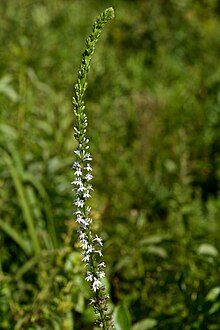| Lobelia spicata | |
|---|---|

| |
| Conservation status | |
 Least Concern (IUCN 3.1) | |
| Scientific classification | |
| Kingdom: | Plantae |
| Clade: | Tracheophytes |
| Clade: | Angiosperms |
| Clade: | Eudicots |
| Clade: | Asterids |
| Order: | Asterales |
| Family: | Campanulaceae |
| Genus: | Lobelia |
| Species: | L. spicata |
| Binomial name | |
| Lobelia spicata Lamarck | |
Lobelia spicata, commonly called the pale spiked lobelia, is a flowering plant in the bellflower family.
It is native to North America, where it is widespread in southern Canada and the eastern United States. It is found in a variety of sunny and semi-shade habitats, including prairies, glades, woodlands, and disturbed areas. Several varieties have been recognized across its range, although their distinction is still uncertain.
It is a short-lived perennial, usually flowering below taller grasses and forbs. It produces a spike of white or pale blue flowers in the summer.
References
- Maiz-Tome, L. (2016). "Lobelia spicata". IUCN Red List of Threatened Species. 2016: e.T64317299A67729992. doi:10.2305/IUCN.UK.2016-1.RLTS.T64317299A67729992.en. Retrieved 12 November 2021.
- Alan Weakley (2015). "Flora of the Southern and Mid-Atlantic States".
- "Lobelia spicata". County-level distribution map from the North American Plant Atlas (NAPA). Biota of North America Program (BONAP). 2014. Retrieved 11 December 2017.
- ^ Yatskievych, George (2006). Flora of Missouri, Volume 2. Missouri Botanical Garden Press. p. 751.
- IllinoisWildflowers
| Taxon identifiers | |
|---|---|
| Lobelia spicata |
|